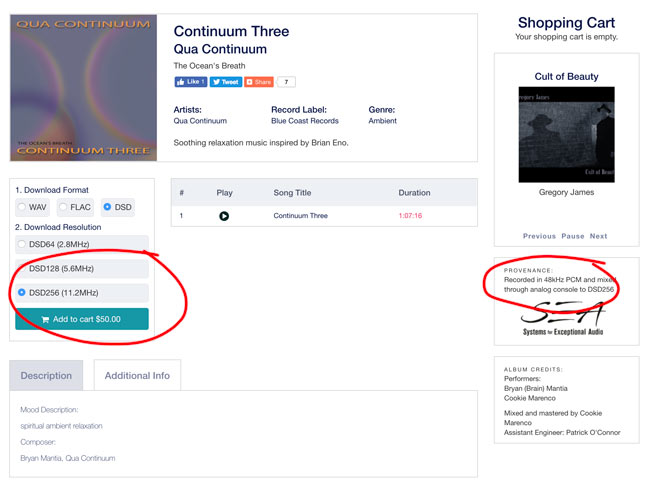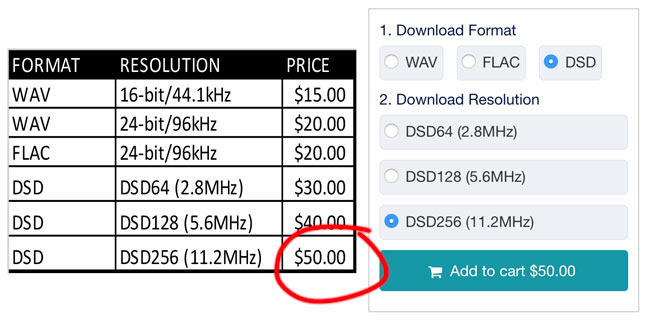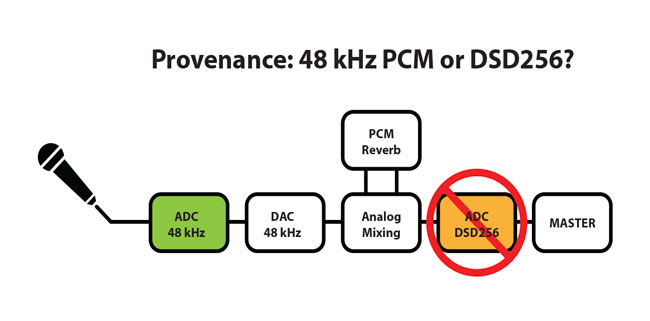Provenance, Pricing, PCM, and Profits!
I received an email from a long time reader this morning asking my thoughts about the album “The Ocean’s Breath – by Quo Continuum” a new project offered by Blue Coast Music featuring label owner, producer, engineer, and musician, Cookie Marenco. I have very high regard for Cookie and her releases — I consider her a friend and colleague in the high-end audio world. Her productions are excellent and worthy of consideration by anyone looking for reference material. She’s an accomplished producer and engineer, successful audiophile label owner, musician, and strong advocate for the DSD format.
The reader expressed a great deal of confusion about the provenance of the album. He wrote:
“Found a good one for you that has me very confused. It comes from Blue Coast Music and is for one of their latest albums. I am interested in buying it and always look for the resolution and format an album is recorded in and try to get the closest matching (i.e. least messed around with) format. So in the bottom right there is a box labelled provenance and it says the following: Recorded in 48kHz PCM and mixed through analog console to DSD256. So, in my mind I am looking for a 48kHz PCM file as the “original” but the DSD256 is confusing me because if they directly analog recorded it to DSD256 (a very tricky thing to do) that would be the “original” but then the 48kHz PCM makes zero sense. I am not sure what they actually did as it is so contradictory.”

So the question is — what can a purchaser expect in terms of fidelity for this new album? Is it the ultimate fidelity established by mix capture at DSD 256? Or perhaps the fidelity was locked in during the initial capture at 48 kHz PCM (there is no mention of bit depth in the “PROVENANCE” section of the page)?
Bigger Numbers – Bigger Price?
And making the decision even tougher is the pricing variables offered on the same page. This mornings email inquired about the format/pricing matrix as well
“Now to make things really complicated here is what is actually for sale in the download formats:
- WAV – 16bit/44.1kHz – $15 (so CD quality but definitely format converted and not from an even multiple so not the greatest choice)
- WAV – 24bit/96kHz – $20 (so better quality and at least an even multiple of 48 but why would I pay for more than was recorded?)
- FLAC – 24bit/96kHz – $20 (I assume this is the same as the above file just converted to flac so I would get this because the metadata is likely already embedded which makes it easier to handle)
- DSD64 (2.8Mhz) – $30 (not sure how this one came about but looks like a downsample of the DSD256 conversion from the 48kHz PCM recording – whoa!)
- DSD128 (5.6Mhz) – $40 (same as above only even more expensive and only downsampled by a factor of 2 instead of 4 for whatever that is worth)
- DSD256 (11.2Mhz) – $50 (if this album was recorded live using an analog mixer directly to DSD256 then this is the “original” but it doesn’t sound like it was. Are you kidding me $50 for an album!!!)
WTF! I am interested in this album but could they make it more confusing as to what format to buy? I appreciate that they want to “help” by putting the provenance there but that actually makes it more confusing. Looks like the 24bit/96kHz is likely the best choice.”

“…converting the multitrack master from 48 kHz PCM to analog in order to mix the project in analog and then re-digitizing the output at DSD 256 means the final master has gone through a couple of unnecessary conversions.”
It’s interesting that the resolution of the original master — 48 kHz PCM (is it 24-bits?) — as indicated in the provenance section of the first image above is NOT even offered for purchase! Why? Because the album went through a few unnecessary conversions from multitrack master to final mixdown. I don’t know if Cookie prefers to mix through her analog console because she likes the “sound” of it (a perfectly valid choice) or whether her studio lacks digital mixing capability, but converting the multitrack master from 48 kHz PCM to analog in order to mix the project in analog and then re-digitizing the output at DSD 256 means the final master has gone through a couple of unnecessary conversions. And remember each time an audio signal is converted from digital to analog or the other way around fidelity is lost. I imagine that Cookie is also using digital reverb (PCM format) in her productions, which adds another couple of conversions — at least for the reverb heard on the album.

The truth is that Cookie’s recordings sound great because of her sensitivity to mic placement, the layout of her studio, and her production philosophy NOT because they are upconverted to DSD! I’m unwilling to spend the money necessary to download and compare the quad rate DSD version to the 44.1 kHz/16-bit version but I’m pretty confident that I would prefer the one at the original resolution. And while I applaud her inclusion of the “provenance (a term that I first applied to high-resolution music in 2000)” for the project, I find it a little disingenuous — and confusing — to charge more than 300% more for an upconverted DSD256 file. The fidelity of this album was locked in during the original capture at 48 kHz! The irrational belief that anything offered in DSD is worth more is “fake news” to use the parlance of the times.
Other labels and services do essentially the same thing — stuffing standard-resolution music in high-resolution containers in the hopes that people will pay higher prices, purchase new equipment, and rave about their new found fidelity. We should know better by now.
My friend Morten Lynberg, owner and chief engineer at 2L, works the other way around. He starts with ultra high-resolution DXD (PCM at 352.4 kHz/24-bits) and then offers a variety of formats and resolutions derived from the high-resolution master. He downconverts to PCM and DSD — but still charges more for DSD!
++++++++++++++++++++++++++++++++++++++++++++++++++++++++++++++++

My younger brother is in need of some help. This isn’t the place or platform to relate the details of his current situation but I know some of you might consider making a contribution to the GoFundMe campaign I started for him once you read the narrative I wrote. In fact, since I posted this a couple of weeks ago, readers have given generously. Together we’ve raised over $3200! I can’t thank you enough.
I wouldn’t make this appeal if I didn’t feel his circumstance was compelling and my younger brother very worthy. If you want to read more, please click the link below — and please consider making a contribution.
To thank anyone that makes a donation of $100 or more, I will send a signed copy of my “Music and Audio: A User Guide to Better Sound” (with Blu-ray Demo disc) AND a FREE copy of the latest AIX Records sampler— a $25 value. If you contribute $50 – $100, I’ll send the eBook, downloadable files, and the AIX sampler. Finally, for a donation of $25 – $50, you’ll receive the eBook and demo files.
I will cover all shipping expenses for domestic orders. International shipping will be additional.
Click here to be taken to the GoFundMe page.
Please do not share this link. Thanks for your consideration. And thanks to those that have generously contributed to the GoFundMe campaign!


Is it possible that the various formats invoke different circuits, filters, decoders, etc within the DAC such that it results in a different sound signature even though they each may have originated from the same source recording before conversion?
Absolutely. If Cookie prefers the “sound” of DSD — and I know she does, then she certainly has the right to record and produce DSD albums. Where I have a problem is when you record at a lower specification in PCM and then market upconversions in DSD 256 at $50! There is nothing about the sound of DSD that contributes better fidelity at 256 than DSD 64. This appears to me to be a money grab.
“He downconverts to PCM and DSD — but still charges more for DSD!”
Mark, As usual the ole adage “a fool and his money are soon parted” applies well here. 😉
I think most of us all love how you cut to the chase. How come most of the subjectivists, can fall for these Bogus Marketing ploys. Upsampling, downsampling. What was the original recorded in? The more complex the marketplace is, the more room for Bamboozlement. No sense having a Audiophile commentary with a unarmed, opponent. Thanks for the data.
Glen, I probably wouldn’t have waded into this territory again (I’ve already written several blog posts about the nonsense of upconversions or cross conversions to DSD) but for the email I received from a ready. I know and respect Cookie’s work but would — and have — challenge her with regards to the issues mentioned in this piece.
Great term bamboozlement! Would there be any balonyum in that, as I have a food allergy?
Cheers.
If you’re not sure about something it helps to ask – a simple email to Cookie would have clarified this situation. The bottom line is this project was captured to DSD256 so this IS the original. The source material was computer based at varying resolutions before being mixed in analogue then captured to DSD256.The question of wether or not the various other DSD and PCM qualities of this being offered are better/worse is a totally different question.
John, I’m not unsure about the provenance of this production. I have spoken to Cookie about her production techniques and understand her reasons for using her analog mixing console. You’re incorrect when you state that the original is the DSD256. The DSD256 is the mixdown master NOT the multichannel master, which she indicated was 48 kHz PCM. Whatever sound modifications she applied during the mixdown (EQ, digital reverb, panning, levels etc.) pass through the analog stereo bus and then captured to her DSD256 recorder. And while there may be a “sonic” flavor associated with the analog desk the frequency response, the dynamic range, and all other fidelity components are defined by the 48 kHz PCM multichannel recording NOT the DSD256. While I’m not a fan of using 1-bit recording (which is not actually how DSD is done) at any rate, a DSD64 capture would likely capture all of the “analog console” nuances that you desire. The thought that any signal out of an analog console is worthy of capturing at ultra hi-res specs will enhance the fidelity is misplaced.
Hi Mark,
Firstly, I have to nail my colours to the mast so to speak and say on personal recent experience I am now convinced DSD has an advantage over PCM in terms of capturing music, why? I don’t know but I’m becoming convinced it’s in the timing domain due to its bonkers high sampling rate. I’m happy to be proved wrong.
My understanding is these Qua Continuum recordings are a mixture of samples and sounds built up in computer PCM based form but then rendered through an analogue console and mixed to create the music Cookie has wanted. I understand and agree with your point about fidelity being locked in and if this recording in its completed form had been captured in PCM then I would buy it in that format but in this specific case the mixing and therefore altering of the source material in the analogue domain is the crucial difference and therefore capturing to DSD256 seems perfectly logical especially as it is the default digital format that Cookie records in as She prefers the sound of DSD over PCM.
Cheers
John Deas
A preference for DSD is your choice certainly. My personal preference is for formats without all of the limitations and compromises…and that’s PCM.
Cookie is not alone in opting to mix through an analog mixing desk, use analog EQ, add digital reverb (PCM-based because DSD cannot do DSP), and then capturing the output in another digital format. Using DSD256 provides no benefit other than to raise the “perceived” value of the files since the provenance is limited to 48 kHz PCM. Where I diverge from this approach is when individuals believe that the pass through analog electronics, exotic analog circuits, and then into a “high-resolution mixdown format magically elevates the fidelity to “hi-res”. It doesn’t.
Totally agree DSD has limitations, certainly at present due to being ‘non-mixable’ in contrast to PCM where all the tools and hardware are available en-masse to do this. I don’t believe Cookie is trying to con people with some idea that there is a ‘high-resolution’ mix down’ going on here, just capturing the resulting analog mix in what She believes is the best format digitally for that and making it available.
But then why charge 2.5 times more for something that has no greater fidelity?
She believes this is the best fidelity to offer. People are not being forced to buy the most expensive version, Cookie is making it available in many different resolutions including CD. I agree people need to understand all this stuff but let’s be honest most people who are going to buy from Blue Coast are probably pretty savvy about the formats and can choose accordingly. Again, your original correspondent just needed to email and He/She would have been explained the why’s and wherefores, there is no dodgy dealing going on here…
She does believe that DSD provides better fidelity (even though studies have shown that no one can tell PCM and DSD apart!) but she is also savvy enough to understand the nature of audiophile thinking, marketing, and maximizing profits. Looking at comments from audiophiles across the web that believe in crazy expensive power cords, isolation pads for hard drives, and who have little understanding of how albums are actually produced, I do not believe that her customers understand that there is nothing DSD256 offers to this master over the 44.1/16bit $15 version. Other questionable (actually outright false) claims are made on her website such the nonsense that MQD (basic recordable CDs) are capable of producing better sound than standard replicated discs. The passage on her website states (with a straight face!), “…we have noticed an increase of approximately ½ db in volume along with better frequency response and enhanced imaging when compared to our former mastering discs.” I hope you agree that this is undisputedly “dodgy”.
Thanks for calling out these bamboozlers. I wish the industry as a whole would police itself better. I still find it insane you were kicked out of an audio club for telling the truth!
Interesting that music revenue is up due to streaming growth — https://www.forbes.com/sites/billrosenblatt/2019/03/02/the-warning-signs-among-the-music-industrys-revenue-growth/#5dad68e17de3